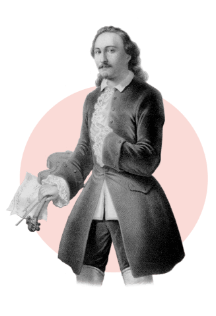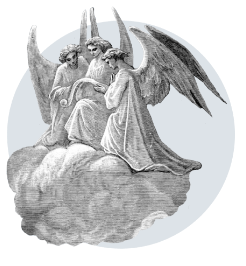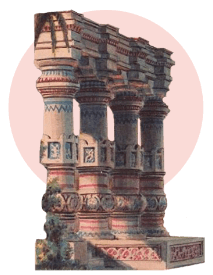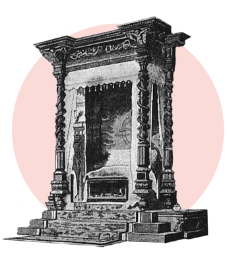In the world:
Decembrist
revolt
in Russia

First railway
(Britain)
Champollion's
expedition
to Egypt

July Revolution
in France
The Belgian Revolution
Invention
of the telegraph
First
electric motor
Beginning of
Queen Victoria's reign
in Britain
Invention
of daguerrotypy —
the first technology of making photos
Discovery of
Neptune
Revolutions in Italy,
Austria, Germany
and France

First World Exhibition
in London
Russia's defeat
in the war against Turkey
Colonization of India
by the British Empire

Abolition of serfdom
in Russia
First metro system
(London)

Periodic table by Mendeleev
Opening of the Suez Canal

Invention
of the telephone
End of the Russo-Turkish war.
Independence of Romania,
Serbia and Montenegro

Assassination of Alexander II
in St. Petersburg
First tram line (Berlin)
Eruption of
Krakatoa
volcano
in Indonesia
First manned
trip by zeppelin
Opening of
the Statue of Liberty
in New York
World Exhibition
in Paris.
Opening of
the Eiffel Tower

Establishment of the Nobel Prize
Invention of the radio and X-ray radiography
First cinema show (Paris)
First
airplane
flight
Beginning of the
Russo-Japanese
War

Fall of
the Tunguska
meteorite
Family Petipa
The Petipas were a model of an artistic family of the XIX century. The legendary ancestress — the artist of the Royal music academy (now Opéra de Paris) with a surname meaning «a small pas». Parents are a dancer and a ballet master Jean-Antoine Petipa and a dramatic actress Victorine Morel, stage name — Grasseau. Five children had been prepared for stage from a young age. All together they roamed around the European province in search for favorable engagements and with a secret dream of an ambitious target — capital glory. This dream came true for the eldest son Lucien when he became a premier of Opéra.
Ballet worldview
of the middle of the XIX century
Until the 1870s, Paris was the capital of the world ballet and home to the oldest ballet school and troupe. In addition to the network of large courtyard stages, there was a powerful infrastructure of small theatres showcasing numerous private theatrical productions. Dancers and choreographers circulated around Europe in search of attractive contracts. As a result, the track record of each ballet star of the 19th century included at least a dozen cities. At the time, St. Petersburg was a remote, yet rich province with perfectly equipped scenes. It took over the title of the ballet capital after the era of Marius Petipa, when ballet in other countries had fallen into decline.
Years of wandering
Since his childhood Petipa knew very well that dancers live by their legs — in all meanings: keep your eyes open and a travelling trunk ready, look for the most favorable engagement and when you find lucrative job, hold on for dear life wherever you are. His career wasn’t so distinguished and easy as he will write in the latest memoires: in Nantes, Bordeaux, Madrid success didn’t come immediately, he had to fight for main parts — once Petipa was even forced to explain in a newspaper of Bordeaux that he doesn’t claim for main roles, working on secondary ones.
Duel and escape
Soon after Petipa received engagement in Teatro del Circo in Madrid he was invited by Marquise Villagarcía to give dance lessons to her daughter Carmen Mendoza y Castro. The teacher began to romance his student and persisted against Marquise’s reaction: there was a rumor that the dancer romanced both the mother and the daughter the same time. In the autumn of 1844 there was a duel between an admirer of Marquise (his name is to be defined) and in January 1844 Petipa ran with his beloved. They have been travelling with fake documents for two months: the search for the runners became a subject to diplomatic correspondence between France and Spain.
To Russia
In two months after dona Carmen was captured Petipa hurried to leave to Petersburg where the theatre season was already closed. It seems that engagement in distant but rich province was procured for him by his eldest brother Lucien Petipa, etoile of Opera. Their mediator was a French Antoine Titus being that time the head of the Saint Petersburg ballet. For Marius who had difficulties with French justice everything chimed together: a premier Emile Gredlu had just left Saint Petersburg and they needed a replacement.

The interiors of the Crystal Palace at the World Exhibition in London
World exhibitions were the main symbol of the colonial era, a place where Europe demonstrated achievements and the beautiful future of mother countries and exemplified the extraordinary life of colonies. Petipa's “Big Ballets” largely replicated the model of the world exhibitions.
First ballets
Petipa had his debut as a ballet master soon after arrival — together with a dancer Frederic he staged a Paris novelty, «Paquita» by Joseph Mazilier. Dances in operas are a main part of his work in Imperial theatres — Petipa began to stage in 1849. Following performances were either revivals of foreign ballets or premiers without mentioning the name in the bill or courtyard shows that didn’t need bills at all, so originality of Petipa’s work here is rather doubtful (for instance, «La Rose, la violette et le papillon»). The list of his own works provided by Petipa in memoires is full of mistakes and the most accurate list so far is one published in 1971.
List of Petipa’s stagings in Russia / Marius Petipa. Materials. Memories. Articles
The second ballet master
For long time Petipa occupied in Petersburg the position of premier danseur; the critics payed tribute to him as an excellent mimic. In 1855 he also began to teach in Theatre school. Not very often he put on dances in operas, so called living pictures, separate pas and small ballets — also for the tours of his wife Maria Surovshikova-Petipa. In 1861 Petipa had a chance to stage a big ballet for the benefit of Carolina Rosati. There were only 6 weeks for rehearsals — a negligible period of staging four acts. Petipa took a try and it worked. The premiere of «The Pharaoh’s Daughter» was on the 18th of January 1862 and on the 19th of April the author was appointed as a ballet master of Imperial theatres.

Arthur Saint-Leon (1821—1870), dancer, violinist, choreographer. Ballet master of the Imperial Theatres in 1862—1869
The first ballet master
For almost whole XIX century the ballet of Saint Petersburg was led by French: Charles Didelot, Alexis Blanche, Antoine Titus, during the years of Petipa’s work — Jules Perrot and Arthur Saint-Léon. The latter was Petipa’s teacher and competitor. Saint-Léon didn’t give lessons to his younger colleague but many of composing vehicles and scenic effects were taken from him; Petipa absolutized them after departure of Saint-Léon when he became the head of the ballet of Saint Petersburg and began to stage big and small ballets each year, his own and by his predecessors, each time arranging a typical set of pas and stable hierarchy of the company (ref. How is Petipa’s ballet organized).

Gustave Dore. Illustration to “The Divine Comedy” by Dante (“Paradise”). 1861
Gustave Dore's engravings were extremely popular at the time and often served as models for corps-de-ballet groups and ensembles in Petipa's ballets. They give the key to understanding Petipa’s ensembles, which are covered in lush clouds of fabrics rather than purely geometric, as they began to be presented in the 20th century. In particular, Petipa studied Dore's illustrations of “The Divine Comedy” while composing “The Kingdom of the Shades” in “La Bayadere”
“La Bayadere”
Of the many ballets of Petipa staged in the 1870-80s, “La Bayadere” is the only one that survived until present day. It is a perfect piece that displays the various elements Petipa used as a basis for his ideas and ballet scripts. The genealogic tree of “La Bayadere” includes Aubert's “The God and the Bayadere”, Filippo Taglioni's “Shades”; brother Lucien's Parisian “Sacountala” and Milanese “Brahma”. It has echoes of the 1870s Indo-British political conflicts and Verdi's “Aida” staged in St. Petersburg shortly before. Besides, the final version of “La Bayadere” of 1900 could not be possible without three editions of “Mlada” with a similar “Shades scene”, without “Roxana” and “Zoraya”, which have the same exotic flavor, nor without Petipa's collaboration with ballerinas Carlotta Brianza and Pierina Legnani.

Carl Grunner. Scenery sketch for “La Bayadere”, 1884
© State Central Theatrical Museum named
after M. Bakhrushin

Ivan Vsevolozhsky in the home caftan of the boyar of the 17th century. Photo from “The album of the costume ball at the Winter Palace in February 1903”
Ivan Vsevolozhsky (or, as he called himself, Vsevolozhskoy) was head of the Imperial Theaters from 1881 to 1899 and was a perfect director and impresario for Petipa. Today we would call him a curator or an intendant: it was he who initiated the production of “The Sleeping Beauty”, “The Nutcracker” and “Raymonda”, invited Tchaikovsky and Glazunov. In addition, he acted as an anonymous author of costumes for Petipa's ballets for 20 years.
Time of chef d'oeuvres
In 1890 Petipa stages «The sleeping beauty», in 1900, being an 82 years ancient, makes the final revision of «La bayadere». During this decade were created and edited all those ballets that still form a skeleton of the world repertoire. By the beginning of the XX century almost whole actual repertoire of Imperial ballet belonged to Petipa: his ballets or operas with his dances were given practically each day and sometimes in the morning and in the evening. Authorial theatre of Petipa wouldn’t have been possible without his colleagues. Except for Tchaikovsky and Glazunov they are the director of Imperial theatres Ivan Vsevolozhskoy; the second ballet theatre Lev Ivanov; ballerinas Carlotta Brianza and Pierina Legnani; a bandmaster and composer Riccardo Drigo; decorators Matvey Shishkov, Mikhail Bocharov, Petr Lambin and others.

The interiors of the castle of the sleeping beauty, the decor of Konstantin Ivanov. Illustration in the Yearbook of the Imperial Theaters, 1892

Mikhail Zichi. Marriage of Grand Duke Alexander Mikhailovich and Grand Duchess Ksenia Alexandrovna, daughter of Alexander III, in the Cathedral of the Grand Peterhof Palace on July 25, 1894
Iconography of the late 19th century helps us to understand the concepts of beauty and “pleasure” that prevailed at the time and the way the world was seen — mostly as a set of postcards, “album pages” richly decorated with vignettes. Naturally, Petipa's ballets represented the same type of worldview and the visual appearance.
The end of the fairy-tale
In the 1900s Petipa was going strong: he staged a series of chamber ballets, prepared for the premiere of «The magic mirror» in four acts, thought about «Love affair of Rosebud». But there was no whilom peace and stability: the position of director was taken by Vladimir Teliakovsky who didn’t like Petipa; academical artists who used to mount ballets were replaced by Konstantin Korovin and Aleksander Golovin; the premiere of «Love affair..» was cancelled. At the general rehearsal of «The magic mirror» the mercurial prop mirror cracked — historians use to remember that episode as a metaphor of decline of «our inexhaustible ballet master».

Alexander Golovin. Scenery sketch for “The Magic Mirror”.
Petipa was used to staging dances in academic theatrical paintings (see sketch for "The Sleeping Beauty") and could not accept the scenery of Korovin and Golovin. Old ballet reviewers also considered their design inartistic. But the appearance of the new criticism in the face of Volynsky and Levinson promoted the new standard of theatrical painting.
Author’s death
The works of Petipa began their own lives: even in 1900 Aleksander Gorsky stages in Moscow his «Don Quixote» without naming Petipa; his ballets are revived by Pavel Gerdt and Aleksander Shiryayev, revised by Nikolai Legat. Young and angry Mikhail Fokin manifests death of «the old ballet», or the theatre of Petipa. The time of Petipa was at an end but also at the beginning: the whole XX and the beginning of the XXI century the main ideological and artistic fights would figure round his performances — at least, in Russia.
In the music theater:
11/III
Born in Marseille
“The Free Shooter”
by von Weber

Debut on stage in the part of Cupid
(“Cupid and Psyche”, Brussels)
“Prisoner of the Caucasus,
or The Shadow of the Bride”
by Kavos and Didelot
“William Tell”
by Rossini
“Robert The Devil”
by Aubert
“Norma” by Bellini
“Sylfide”
by Schneitzhoffer and Taglioni
“The Elixir of Love”
by Donizetti
XII
Began classes at the Belgian
Conservatory in the violin division
“Lucia di
Lammermoor”
by Donizetti
“A Life for the Tsar”
by Glinka
First independent
engagement
in Nantes
Debut as a choreographer
(“The Intrigues of Love”)
“Giselle”
by Adan,
Coralli
and Perrot

“Ruslan
and Lyudmila”
by Glinka
“The Flying
Dutchman”
by Wagner
13/V
Debut in Bordeaux
in Auguste Deveria's
enterprise
24/VI
Debut in Madrid
Autumn
Duel due to Carmen
Mendoza y Castro
“Esmeralda”
bu Puni
and Perrot

“The Damnation
of Faust”
by Berlioz
Escaped from Madrid
with Carmen Mendoza y Castro
30/V
Arrived in St. Petersburg
26/IX
Debut in St. Petersburg
(Lucien, “Paquita”)

“Macbeth” by Verdi
First production of dances
in the opera (“Stradella” by von Flotow)
“Lohengrin” by Wagner
“La Traviata”
and “Troubadour”
by Verdi

Married to the ballerina
Maria Surovschikova
6/IX
Began teaching in
the boy's class
of the Acting School
“Corsaire” by Adan and Perrault
“The Mermaid” by Dargomyzhsky
“The Trojans”
by Berlioz
“Faust”
by Gounod
18/I
Produced “The Pharaoh's Daughter”
for the first big ballet
19/IV
Got the position
of choreographer
“The Force of Destiny”
by Verdi
“Tristan and Isolde” by Wagner
“The Little Humpbacked Horse”
by Puni and Saint-Leon
Disengagement and separation
from Maria Surovschikova-Petipa
17/X
Premiere of the ballet
“King Candaules”
“Boris Godunov”
by Musorgsky
End of
dancing career
14/XII
Premiere of the ballet
“Don Quixote” in Moscow
“Coppelia”
by Delibes
and Saint-Leon
“Aida” by Verdi
9/XI
Transfer of “Don Quixote”
to St. Petersburg
“The Bat”
by Strauss
“Carmen” by Bizet
Debut of his daughter Maria
in the Imperial Ballet
“The Swan Lake” by Tchaikovsky
“The Ring of the Nibelung” by Wagner

23/I
Premiere of the
ballet “La Bayadere”
29/I
Premiere of the ballet
“Roxana, the Beauty of Montenegro”
“Eugene Onegin”
by Tchaikovsky
1/II
Premiere of the ballet
“Zoraya, the Moorish Girl in Spain”
“The Tales of
Hoffmann”
by Offenbach
“Parsifal” by Wagner
“The Snow Maiden” by Rimsky-Korsakov
Began teaching
in the girl's class
of the Acting School
“Khovanshchina”
by Mussorgsky
Began teaching
in the pantomime class
“Othello” by Verdi
Married to the drama actress
Lyubov Savitskaya
25/I
Premiere of the ballet
“The Talisman”
3/I
Premiere of the ballet
“The Sleeping Beauty”
“The Queen of Spades” by Tchaikovsky
“Prince Igor” by Borodin
“Cavalleria Rusticana” by Mascagni
3/I
Early death
of daughter Eugenia
“Iolanta” and “The Nutcracker”
by Tchaikovsky
“Pagliacci” by Leoncavallo
15/I
Produced “The Swan Lake”
(together with Lev Ivanov)
8/XII
Ballet “Bluebeard” —
a benefit for the 50th
anniversary of service
“La Bohème”
by Puccini
7/I
Premiere of the
ballet “Raymonda”

“The Tsar's Bride”
by Rimsky-Korsakov
“Don Quixote”
by Minkus and Gorsky
Produced the ballets
“Harlequin's Millions”,
“The Seasons”, “The Trial of Damis”
3/XII
Revival of “La Bayadere” —
the final version of Petipa's own ballet
“Pelléas and Mélisande” by Debussy
9/II
“Magic Mirror” —
the last ballet by Petipa
“Jenufa”
by Janáček
“Salome”
by Richard Strauss

8/III
“Chopiniana” by Fokine
(second version)
1/VII
Died in Gurzuf
27/VI
“The Firebird”
by Stravinsky and Fokin






